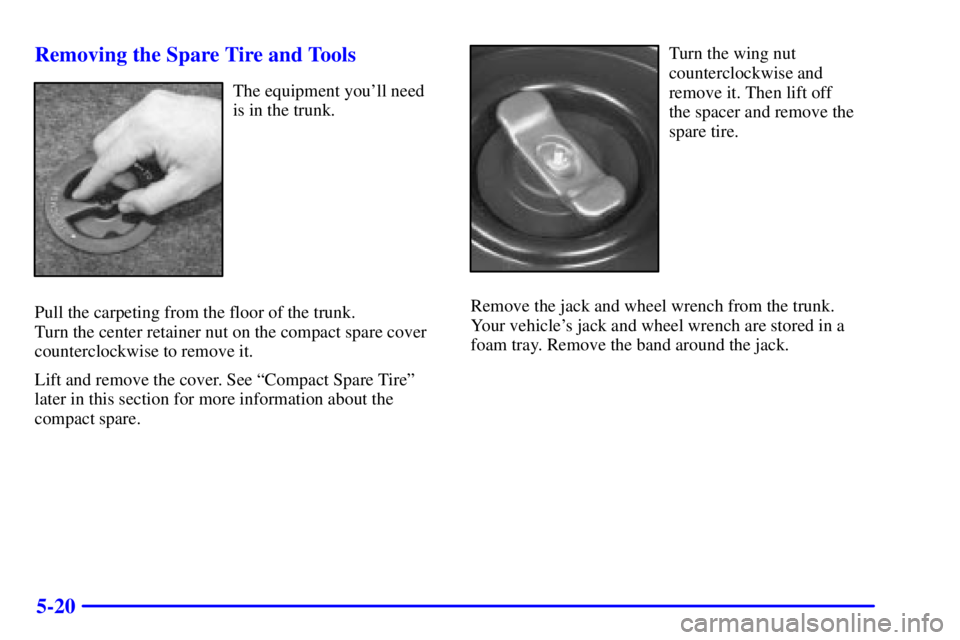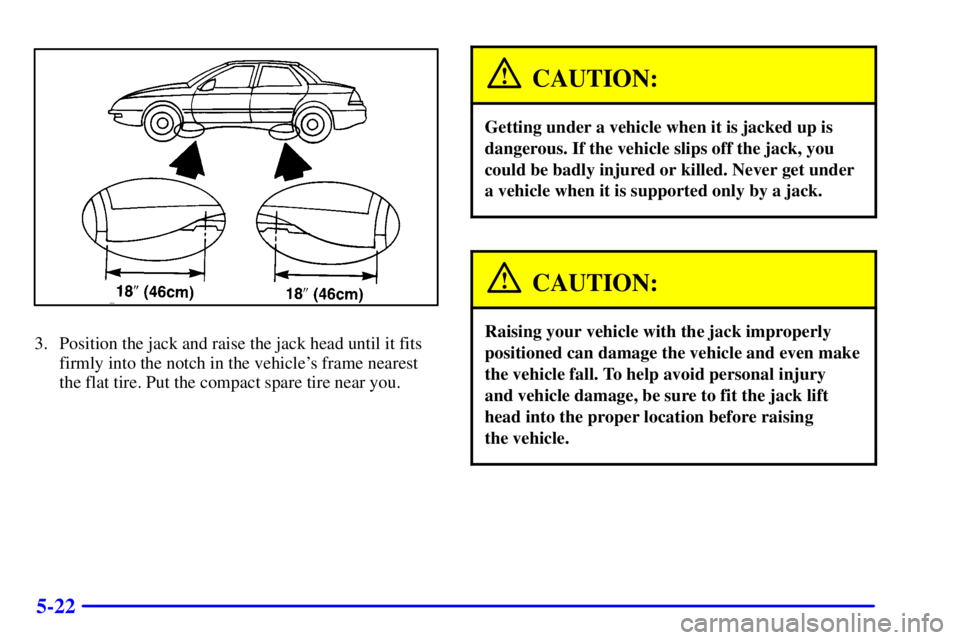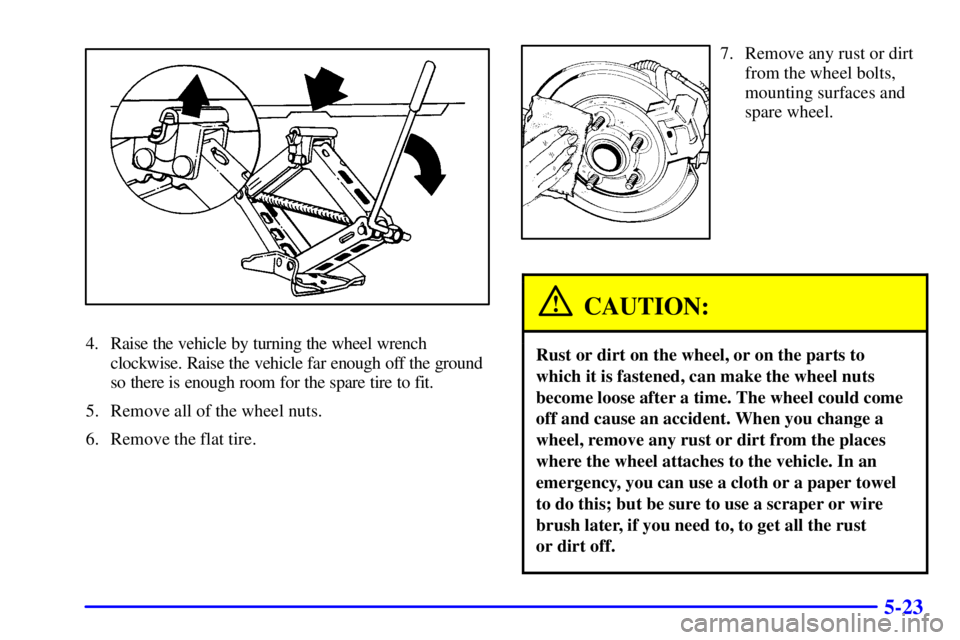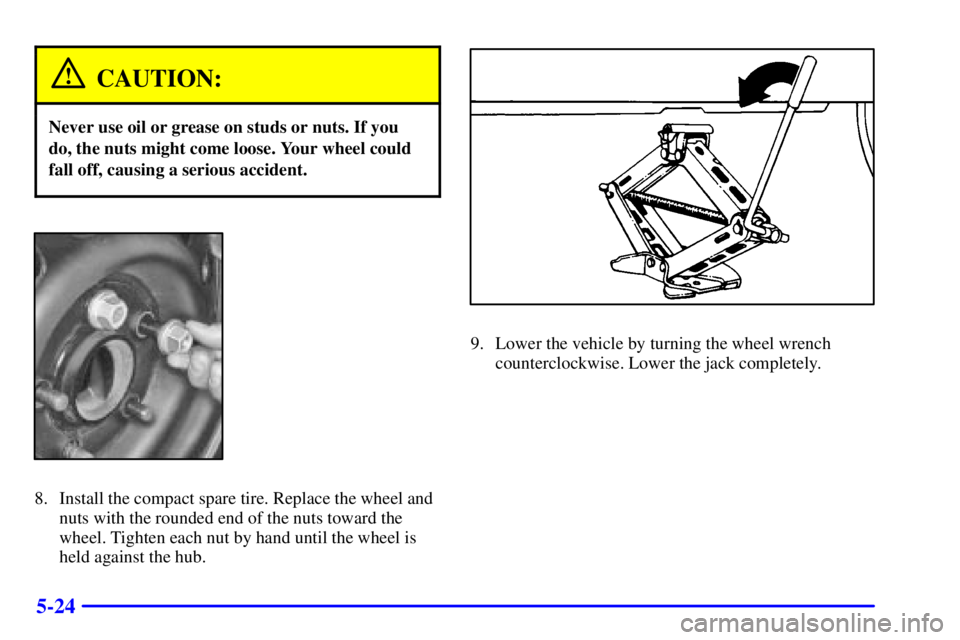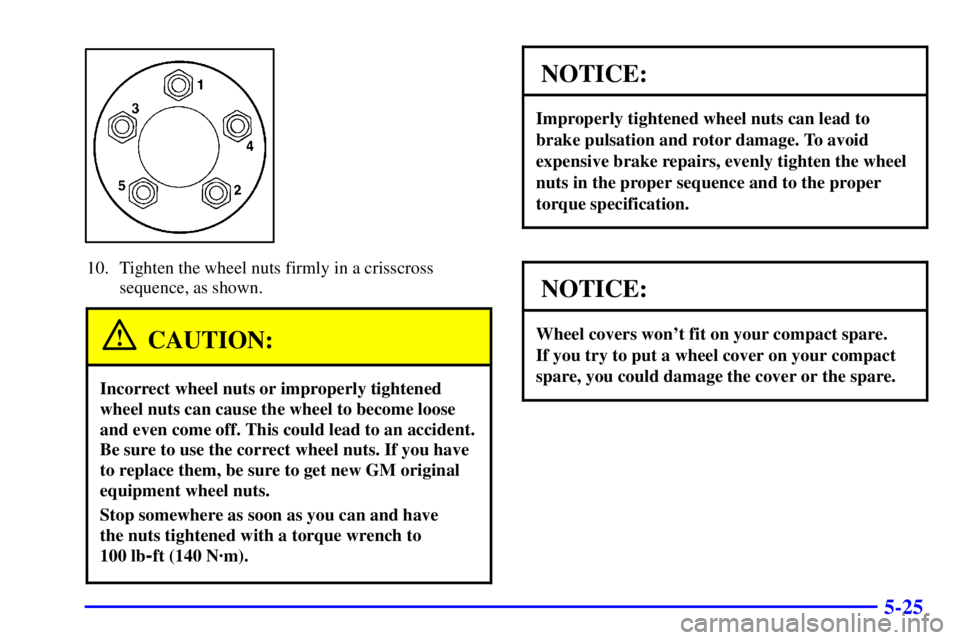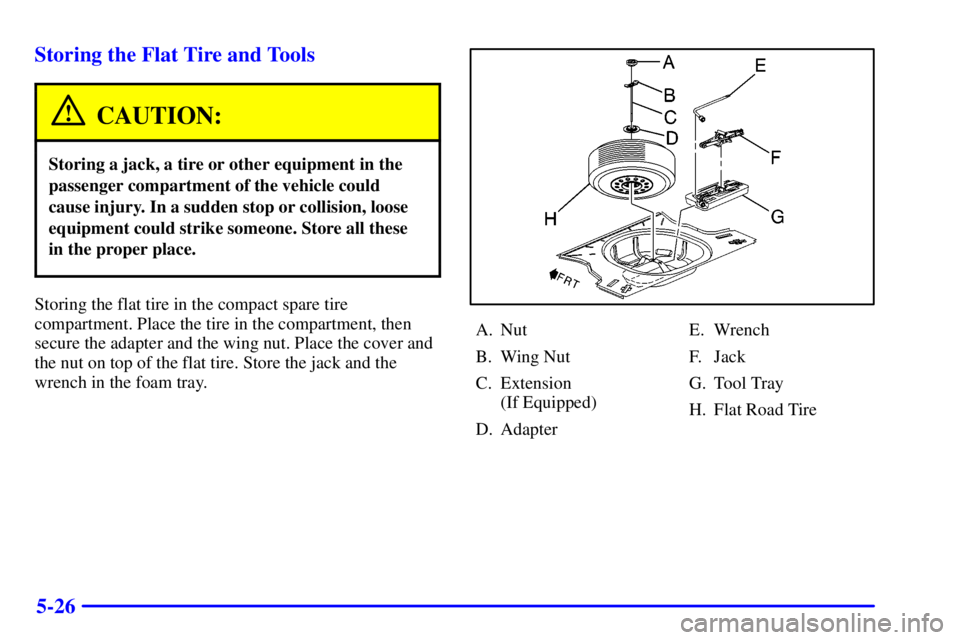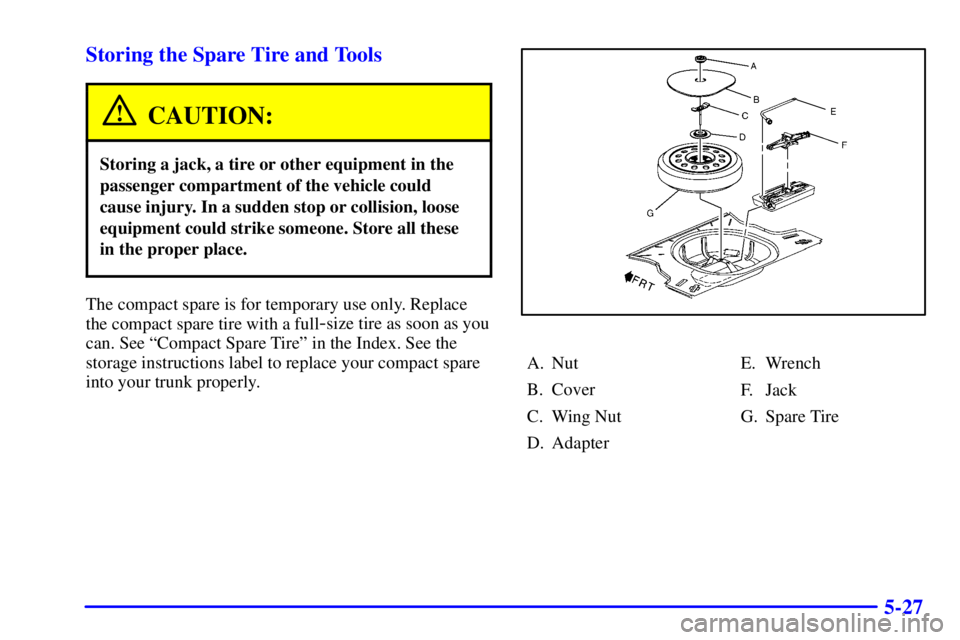PONTIAC GRAND AM 2000 Owners Manual
GRAND AM 2000
PONTIAC
PONTIAC
https://www.carmanualsonline.info/img/50/40834/w960_40834-0.png
PONTIAC GRAND AM 2000 Owners Manual
Trending: spark plugs, change language, reset, fuel reserve, service interval, oil temperature, wiper size
Page 211 of 318
5-19
Changing a Flat Tire
If a tire goes flat, avoid further tire and wheel damage
by driving slowly to a level place. Turn on your hazard
warning flashers.
CAUTION:
Changing a tire can cause an injury. The vehicle
can slip off the jack and roll over you or other
people. You and they could be badly injured.
Find a level place to change your tire. To help
prevent the vehicle from moving:
1. Set the parking brake firmly.
2. Put an automatic transaxle shift lever in
PARK (P), or shift a manual transaxle to
FIRST (1) or REVERSE (R).
3. Turn off the engine.
To be even more certain the vehicle won't move,
you can put blocks at the front and rear of the
tire farthest away from the one being changed.
That would be the tire on the other side of the
vehicle, at the opposite end.
The following steps will tell you how to use the jack and
change a tire.
Page 212 of 318
5-20 Removing the Spare Tire and Tools
The equipment you'll need
is in the trunk.
Pull the carpeting from the floor of the trunk.
Turn the center retainer nut on the compact spare cover
counterclockwise to remove it.
Lift and remove the cover. See ªCompact Spare Tireº
later in this section for more information about the
compact spare.
Turn the wing nut
counterclockwise and
remove it. Then lift off
the spacer and remove the
spare tire.
Remove the jack and wheel wrench from the trunk.
Your vehicle's jack and wheel wrench are stored in a
foam tray. Remove the band around the jack.
Page 213 of 318
5-21
The tools you'll be using include the jack (A) and wheel
wrench (B).
Removing the Flat Tire and Installing the
Spare Tire
1. Remove the wheel nut caps (you may need to use the
wheel wrench to loosen and remove them, if your
fingers do not fit into this small area).
2. Then use the wheel wrench to loosen all the wheel nuts.
Don't remove them yet.
Page 214 of 318
5-22
3. Position the jack and raise the jack head until it fits
firmly into the notch in the vehicle's frame nearest
the flat tire. Put the compact spare tire near you.
CAUTION:
Getting under a vehicle when it is jacked up is
dangerous. If the vehicle slips off the jack, you
could be badly injured or killed. Never get under
a vehicle when it is supported only by a jack.
CAUTION:
Raising your vehicle with the jack improperly
positioned can damage the vehicle and even make
the vehicle fall. To help avoid personal injury
and vehicle damage, be sure to fit the jack lift
head into the proper location before raising
the vehicle.
Page 215 of 318
5-23
4. Raise the vehicle by turning the wheel wrench
clockwise. Raise the vehicle far enough off the ground
so there is enough room for the spare tire to fit.
5. Remove all of the wheel nuts.
6. Remove the flat tire.
7. Remove any rust or dirt
from the wheel bolts,
mounting surfaces and
spare wheel.
CAUTION:
Rust or dirt on the wheel, or on the parts to
which it is fastened, can make the wheel nuts
become loose after a time. The wheel could come
off and cause an accident. When you change a
wheel, remove any rust or dirt from the places
where the wheel attaches to the vehicle. In an
emergency, you can use a cloth or a paper towel
to do this; but be sure to use a scraper or wire
brush later, if you need to, to get all the rust
or dirt off.
Page 216 of 318
5-24
CAUTION:
Never use oil or grease on studs or nuts. If you
do, the nuts might come loose. Your wheel could
fall off, causing a serious accident.
8. Install the compact spare tire. Replace the wheel and
nuts with the rounded end of the nuts toward the
wheel. Tighten each nut by hand until the wheel is
held against the hub.
9. Lower the vehicle by turning the wheel wrench
counterclockwise. Lower the jack completely.
Page 217 of 318
5-25
10. Tighten the wheel nuts firmly in a crisscross
sequence, as shown.
CAUTION:
Incorrect wheel nuts or improperly tightened
wheel nuts can cause the wheel to become loose
and even come off. This could lead to an accident.
Be sure to use the correct wheel nuts. If you have
to replace them, be sure to get new GM original
equipment wheel nuts.
Stop somewhere as soon as you can and have
the nuts tightened with a torque wrench to
100 lb
-ft (140 N´m).
NOTICE:
Improperly tightened wheel nuts can lead to
brake pulsation and rotor damage. To avoid
expensive brake repairs, evenly tighten the wheel
nuts in the proper sequence and to the proper
torque specification.
NOTICE:
Wheel covers won't fit on your compact spare.
If you try to put a wheel cover on your compact
spare, you could damage the cover or the spare.
Page 218 of 318
5-26 Storing the Flat Tire and Tools
CAUTION:
Storing a jack, a tire or other equipment in the
passenger compartment of the vehicle could
cause injury. In a sudden stop or collision, loose
equipment could strike someone. Store all these
in the proper place.
Storing the flat tire in the compact spare tire
compartment. Place the tire in the compartment, then
secure the adapter and the wing nut. Place the cover and
the nut on top of the flat tire. Store the jack and the
wrench in the foam tray.
A. Nut
B. Wing Nut
C. Extension
(If Equipped)
D. AdapterE. Wrench
F. Jack
G. Tool Tray
H. Flat Road Tire
Page 219 of 318
5-27 Storing the Spare Tire and Tools
CAUTION:
Storing a jack, a tire or other equipment in the
passenger compartment of the vehicle could
cause injury. In a sudden stop or collision, loose
equipment could strike someone. Store all these
in the proper place.
The compact spare is for temporary use only. Replace
the compact spare tire with a full
-size tire as soon as you
can. See ªCompact Spare Tireº in the Index. See the
storage instructions label to replace your compact spare
into your trunk properly.
A. Nut
B. Cover
C. Wing Nut
D. AdapterE. Wrench
F. Jack
G. Spare Tire
Page 220 of 318
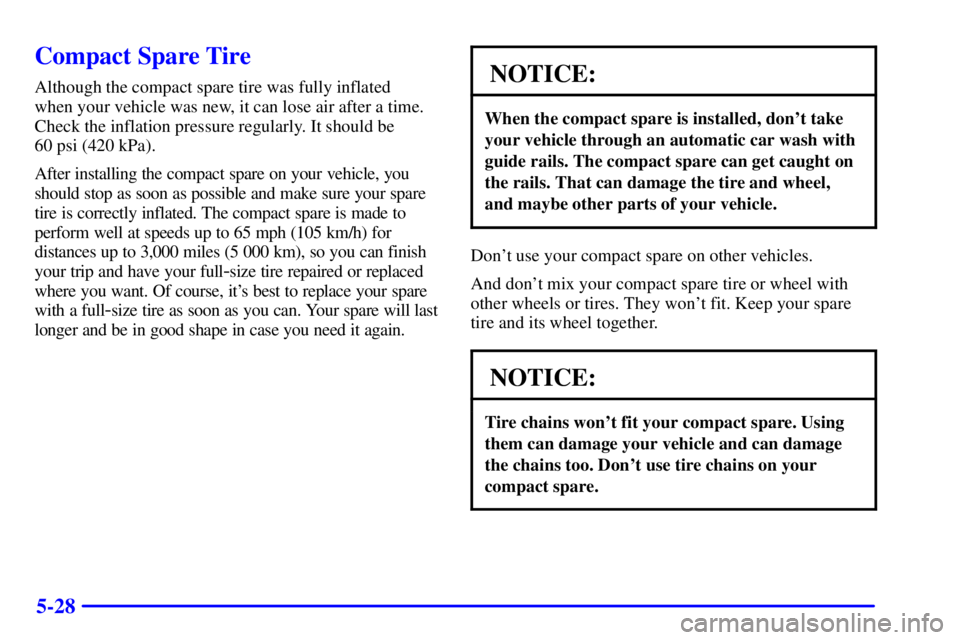
5-28
Compact Spare Tire
Although the compact spare tire was fully inflated
when your vehicle was new, it can lose air after a time.
Check the inflation pressure regularly. It should be
60 psi (420 kPa).
After installing the compact spare on your vehicle, you
should stop as soon as possible and make sure your spare
tire is correctly inflated. The compact spare is made to
perform well at speeds up to 65 mph (105 km/h) for
distances up to 3,000 miles (5 000 km), so you can finish
your trip and have your full
-size tire repaired or replaced
where you want. Of course, it's best to replace your spare
with a full
-size tire as soon as you can. Your spare will last
longer and be in good shape in case you need it again.
NOTICE:
When the compact spare is installed, don't take
your vehicle through an automatic car wash with
guide rails. The compact spare can get caught on
the rails. That can damage the tire and wheel,
and maybe other parts of your vehicle.
Don't use your compact spare on other vehicles.
And don't mix your compact spare tire or wheel with
other wheels or tires. They won't fit. Keep your spare
tire and its wheel together.
NOTICE:
Tire chains won't fit your compact spare. Using
them can damage your vehicle and can damage
the chains too. Don't use tire chains on your
compact spare.
Trending: windshield wipers, lumbar support, bulb, clock setting, power steering fluid, battery replacement, fuel pump

